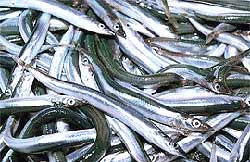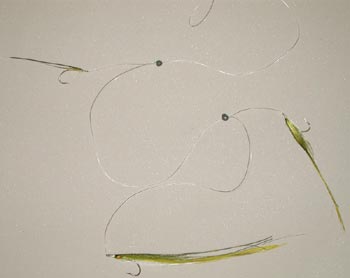
|

Sand
Lance |
||||||||
|
For sand eels 4" and under
|
Notes
Time of Appearance: Late May through Middle August (varies) Along with the silverside the sand lance is a major food source for striped bass in the summer. The length of sand eels varies a great deal from a little less than a couple of inches to nine inches later in the summer. They congregate in large schools and often hold near the bottom near and on the flats. As the tide drops the terns will dive to get them. The coloration of the backs of sand eels found in Moriches Bay are a very dark green and peacock herl is the perfect color. Their sides are made up of reflective prismatic scales. The Moriches Bay sand eels show a strong violet coloration on their sides. The sand eel's body is very narrow in relation to its length. Sand eels can be found anywhere in the water column from just below the surface to the bottom. The sand eel is also found in the bottom. Their slender bodies aid them in burrowing into the sand. Stripers will root them out with their mouth until their noses are scraped up. Tactics on Flats with Sand Eels
If one knows where the sand eels are, then the question is how big are they and where are they in the water column. If it is a low tide flat, then depth is not as important as its size. With an understanding of the structure of the flat find a position from shore (if there is any) or anchor up (I prefer to use a kayak over a boat) that is up current and will allow the fly to drift through the sand eels and ultimately swing across a drop off to deeper water where the stripers will be patroling. What is important to keep in mind when approaching a flat is stealth. One will not know the mood of the stripers until the fishing begins. They may be in a positive mood and not care about ones presence. But if the stripers are in a negative mood, then approaching the fishing area from a distance is critical. The approach to the anchorage will have to be down current. So drift in from as far away as possible. Try not to false cast more than once and let it be over water void of stripers. If the casts are short, feed out line into the drift so the swing will still occur over the deeper water. Good fishing in these situations can be one fish. On many occasions I have anchored and caught a striper on my first cast. Unfortunately, the fight with that one fish can scare the other stripers off and shut that area down. Other times I will be paddling the edges of the flat and actualy striking bass on the head with my paddle. Flats fishing is dependant on the striper's mood. I have great success use a floating line. I will tie on three different sized sand eel flies with the largest at the end. If the water is moving fast, I will start with one split shot above the highest fly. If nothing happens, I will add another split shot above the second fly or increase the size of the split shot. Fast moving water will prevent the flies from sinking to the desired depth. Experiment.
This is an example of three different sized sand eels on a leader. The largest fly is at the point using a uniknot. 18 inches above it is a smaller pattern tied on a dropper (5 turn surgeon's knot) with a split shot attached above the knot and 18 inches above it is an even smaller pattern tied in the same way with a split shot. Then 24 inches to the loop. Finding Sand Eels and Observing Structure
The way I have learned some flats in Moriches Bay is to sacrafice catching stripers in order to observe the structure and note where the sand eels are holding at different stages of the tide. I will note if it is a low tide flat or a high tide flat and how they work with the different tides. I will also watch for the stripers and how they move around the flat. The sand eels will be in shallow fast moving water that is abutt to deeper water (the reason for the fast current) and away from land. Of course, shallow is relative. I've found sand eels in seven feet of water that is next to 15 feet of water. On the other hand, the water will not be too shallow because the terns will easily pick them off. Tern presence is one clue to the presence of sand eels. Often there will be at least a dozen terns hovering low and swooping and diving. |
